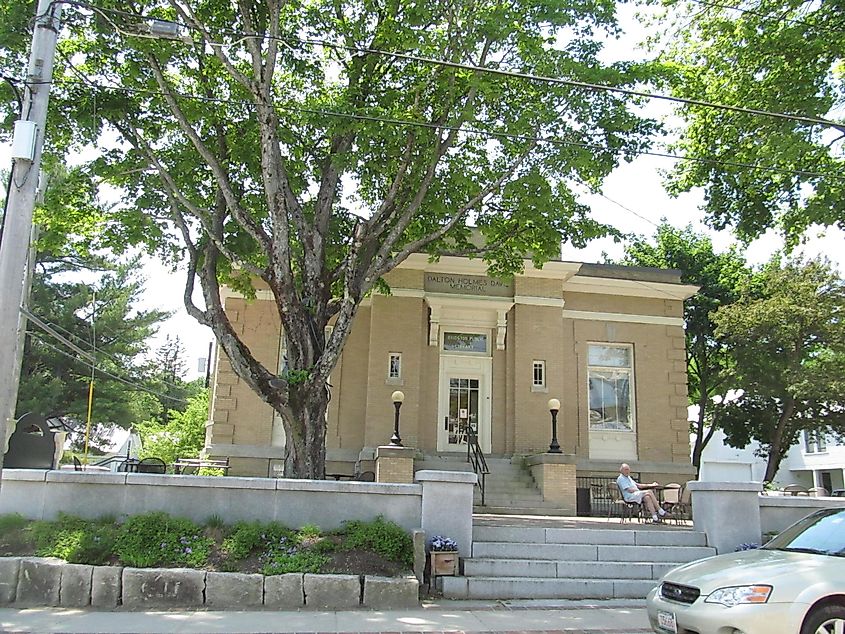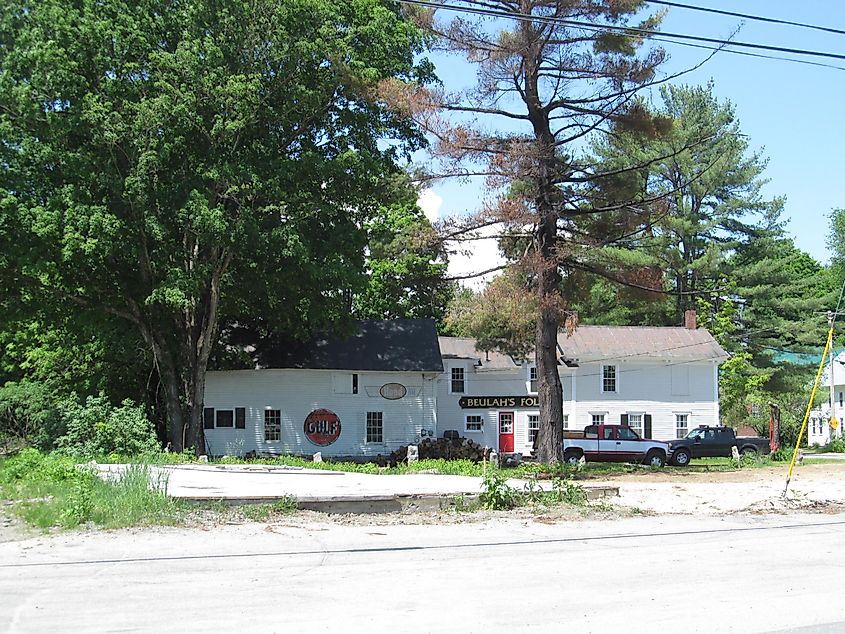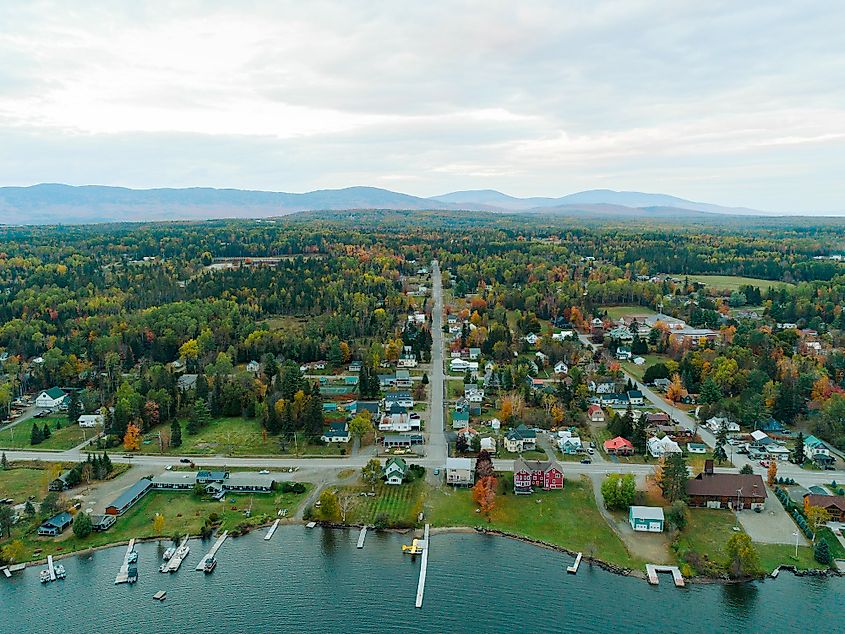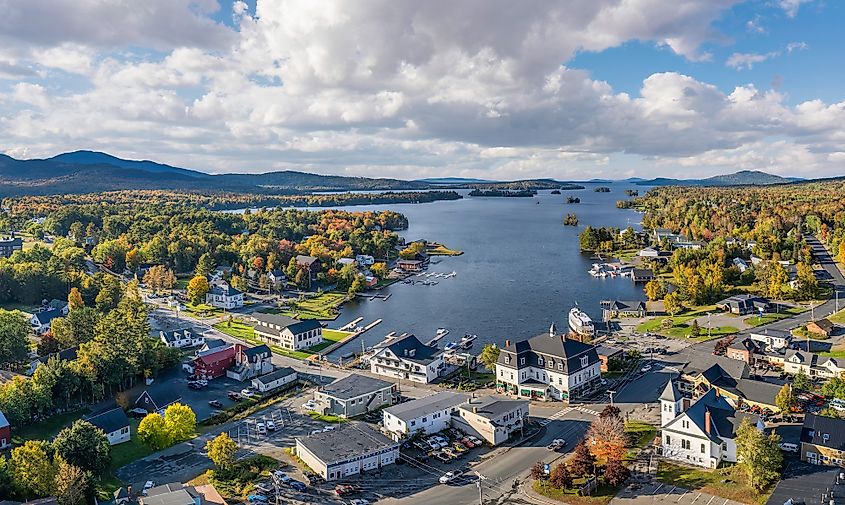
7 of the Quirkiest Towns in Maine
Maine is sparse in people but dense in oddities. Some of the people are oddities, as you will see with a certain horror writer. But many of the oddities are either crafted by nature or by folks and folklore in small towns. There are rural cemeteries with supposedly cursed graves, a 40-acre "desert" in the middle of a forest, a mad scientist's lab and moon gun, and a modern fast food restaurant in a Victorian mansion. Learn about these and other Maine marvels in the following towns.
Bridgton

It is downright impossible to talk about quirky Maine locations without mentioning Stephen King. The king of horror has spent most of his life in the state and set many of his stories in Maine towns, both real and fictional. Bridgton is a real town, population 5,400, that serves as the setting of King's novella The Mist. First, the titular monster-filled mist crosses Long Lake, where King lived with his family while writing the story. Then it descends on the town proper, causing residents to hole up in Federal Foods, which was Bridgton's actual supermarket.
The town now has a Food City, which King put verbatim in his book Under the Dome. He named the domed town Chester's Mill but made it identical to Bridgton, copying its supermarket, hospital, movie theater, police station, and bookstore. The last of those is Bridgton Books, where King himself shops and does signings. The owner has a habit of mixing the signed copies with his regular stock, so literary tourists might be in for a lucrative surprise.
Lovell

Ten miles northwest of Bridgton is Lovell, a scenic lake town with 1,100 permanent residents and many more summer residents, including Stephen King. It is also the site of perhaps the greatest horror of King's life - and we are not talking about a book. In 1999, King was walking on the shoulder of Route 5 near his vacation home on Kezar Lake when he was struck by a swerving van. He was thrown 14 feet and suffered from a collapsed lung, lacerated scalp, broken hip, and a leg so shattered that doctors considered amputation. King recovered, his assailant was sentenced for driving to endanger, and the crime scene became a landmark for the most hardcore King fans. None of that stopped King from loving Lovell, though. It is hard to not love Lovell, being a summer paradise with bars like Ebenezer's, restaurants like Loon's Nest, and myriad watersports unsullied by jetski noise (they are banned on the lake).
Bucksport

View of the downtown and harbor of Bucksport, Maine and the Penobscot River
Bucksport is the Maine town for quirkiness. It was named for Colonel Jonathan Buck, who settled the community in 1763 and died in 1795 with his monument becoming part of supernatural lore. According to legend, Buck accused his mistress of witchcraft and burned her at the stake. But before she died, she cursed him for eternity.

Now, over two centuries later, a mark shaped like a witch's foot stains his monument in a Bucksport graveyard. The anomaly attracts all kinds of people, from credulous thrill-seekers to skeptics who point out the scant historical proof and the completely normal process of oxidation. This stain-causing process can be seen on other historical landmarks, such as Wilson Hall, a 19th century building established as a Methodist seminay, and James Buck House, built around 1830 by Jonathan's grandson. Also drawing people to Bucksport is the grave of Sarah Ware, who was found dead in 1898 and buried headless. Her skull remained in custody for 100 years as investigators tried to solve her gruesome murder. They never did, and her head was finally buried under a small stone near her grave marker. Unlike Buck's curse, Ware's is well documented.
Freeport

On a lighter note, Freeport, a community of 8,700 in Cumberland County, draws tourists with golden sand and golden arches - or lack thereof, in the second case.
Just a few miles west of town lies the Desert of Maine, a 40-acre plot of natural sand in the middle of northern forest. Over a century ago, the area was improperly farmed and overgrazed, which killed all vegetation and exposed underlying glacial sand. So it is not a true desert, but that did not stop people from creating a profitable desert-based tourist destination complete with a campground, mini golf course, and camel statue. Appropriately, it is open in the summer.
After surfing the pseudo-desert, head back to town and gorge on pseudo-McDonald's. Freeport's McD's is housed in a 19th century mansion that has minimal advertising. In 1984, Freeport welcomed the company but, to not besmirch a classy historic district full of revered buildings like Pratt-Soule-Mitchell House and First Parish Congregational, refused their Golden Arches and other gaudy architecture. McDonald's made a rare compromise.
Rangeley

In 1945, a mad scientist built a lab in the hills near Rangeley, Maine, calling it Orgonon after the "orgone" life force he claimed to have discovered. His name was Wilhelm Reich and, after shooting orgone guns at clouds and UFOs and flouting FDA rules with his orgone accumulators, he died in prison in 1957. Today, Orgonon is both a tomb and museum for Reich, which presents the scientist's life and work and tries to rehabilitate his image. The museum is open from July to September while the surrounding countryside, which preserves beautiful trails and one of Reich's "cloudbusters," is open year-round. Outside of Wilhelm's reich, Rangeley hosts a gnome village and a sign from defunct but iconic Doc Grant's Restaurant marking (falsely) the halfway point between the North Pole and the Equator. It is certainly the halfway point between weird and wonderful.
York

York is an amalgam of three York-prefixed communities in extreme southwest Maine. It is also an amalgam of three of the strangest sites in the state. The first is Wiggly Bridge, which crosses the tidal flow between Barrell Mill Pond and York River and is thought to be the world's shortest suspension bridge. The second is the York Witch Grave, which sits in the Old Burying Ground and is believed to contain a witch, human name Mary Nasson, as evidenced by a giant stone slab keeping her buried (alternatively, slabs were used to protect graves from animals). The third is Boon Island Light, the tallest lighthouse in New England, which is just off the coast of York and marks the site of a shipwreck, marooning, and cannibalism of the ship's carpenter from 1710. Old York can bring new thrills.
Greenville

Greenville, true to its name, is a town the size of a village surrounded by greenery. It is in the greenery where the best and quirkiest attraction is found: Elephant Mountain, about 13 miles northeast of town. No, it does not contain an elephant, but it does have the wreckage of the 1963 US Air Force Boeing B-52C Stratofortress crash. Strong gusts tore the tail off mid flight, sending the rest of the plane into the mountain and killing seven of nine passengers. Bodies were recovered but the wreckage was left behind to pepper several acres of forest accessible by trail and macabre hikers. There is also a monument to discover among the rubble. Although green is great in Greenville, so is blue and white. Seaplane rides on Moosehead Lake are an aquatic novelty while the Wilderness Dog Sled Race, which takes place each February, is an awesomely offbeat snow activity.
After all communities have been calculated, Maine might come away with the most oddities per person. Bridgton, Lovell, Bucksport, Freeport, Rangeley, York, and Greenville are low on people but high in offbeat attractions, from horror novel settings to plane crash wreckage. Being one of the oldest states has certainly helped quirkify sites that would not have been quirky hundreds of years ago. We wonder how many more will arise in the next century.











